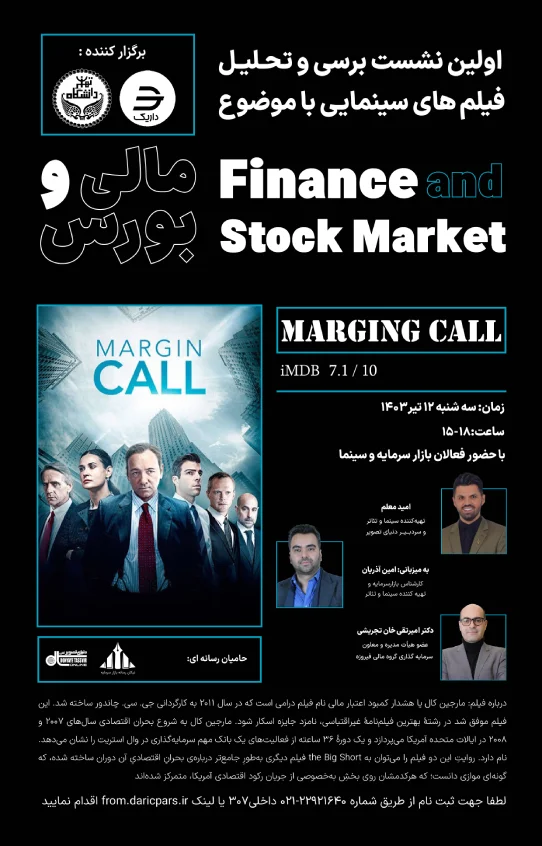
Margin Call Under the Microscope of Capital Market Managers / The First Analysis Session of the Film “Margin Call” in the Stock Market
The first cinematic film analysis session in the financial and economic field, featuring the movie Margin Call, was hosted by Amin Azarian, a capital market expert and the organizer of this program. The event was held on July 2, 2024, with the presence of Amir Taghi-Khan Tajrishi, a board member of Firoozeh Financial Group, Omid Moallem, editor-in-chief of Cinema World magazine, and other capital market and cinema professionals. The session was supported by Darik Pars Portfolio Management Company and the University of Tehran.
At the beginning of the session, Amin Azarian, the host and capital market expert, explained:
“This film is a gripping depiction of the seconds leading to the collapse of a bank during the American economic crisis. By utilizing cinematic elements, it captivates both specialized and general audiences.”
He added: “The film’s director, with his understanding of investment and economic matters, illustrates the impact of environmental signals on both specialists and newcomers. For instance, in the film, the sound of helicopters causes great stress and disrupts the calm for the inexperienced characters. Thus, we must pay attention to various issues and risks without becoming overly excited. Notably, the director’s father was an investment banker in America, and this personal experience informs the film’s narrative.”
Azarian continued: “In our country, there is a misconception that films about the stock market must be produced in a mandated manner, which is incorrect. This enforced approach has no resemblance to the broader concept of cinema. When there is no expertise or in-depth understanding of a subject, the result is ineffective. It’s as though the screenwriter has been forced to insert a concept into their story, leading to superficial and unrealistic outcomes.”
Omid Moallem, editor-in-chief of Cinema World, stated: “This film represents the proper execution of filmmaking in the United States. It’s not commissioned but stems from the concerns and knowledge of its creator. In the U.S., filmmakers first identify a concern and then approach it skillfully, resulting in a purposeful film.”
He added: “This film is essentially a real-life documentary transformed into an engaging drama, which remains thrilling even without action scenes. Despite its specialized concepts, Margin Call is understandable and well-received by general audiences, as reflected in its IMDb score of 7.1 out of 10. The screenplay is crafted to balance the engagement of both specialized and general audiences.”
Moallem also pointed out: “One of the interesting aspects of this film is the age of the characters, which deserves special attention. Additionally, the story unfolds in just one day, rather than over several days. This adds to the film’s appeal, as it portrays a critical issue that necessitates an emergency meeting at 3 a.m., with even the CEO arriving by helicopter. This immediate engagement is one of the film’s strengths.”
Amir Taghi-Khan Tajrishi, a board member of Firoozeh Financial Group, observed: “The film showcases how behaviors can trigger a crisis. In the organization at the center of the story, trivial and unnecessary issues are emphasized, while the main problem is overlooked. Consequently, the crisis manager is easily dismissed, and the company plunges into turmoil.”
He emphasized: “One of the key roles of cinema is to delve into specialized fields that may not be easily digestible for the general public. Cinema’s ability to simplify complex topics, such as stock market crashes, is extraordinary. One of the strengths of American society is its dynamic cinema, which provides forward-looking warnings. A good policymaker allows cinema to voice its concerns and pays attention to them.”
This seasoned capital market professional stated: “Unlike browsing the internet, which often fosters an illusion of knowledge due to shallow understanding, books and structured classes provide a deeper grasp of subjects. Cinema can simplify books for those who lack the time to read, helping prevent disasters from recurring. In Iran, however, we tend to conceal issues by turning them into security concerns instead of addressing and learning from them.”
He added: “This film repeatedly underscores the fast-paced decision-making required in a volatile market. Every character in the film is striving for advancement, and financial matters dominate their lives. One reason large sums of money are invested in American cinema is to retain geniuses in the cultural sphere, preventing them from diverting to other fields. This fosters cultural enrichment for society.”
He concluded with a critique: “The system depicted in the film is designed in a way that the wealthy become wealthier while the middle class descends to lower tiers. However, the film also highlights the distinctions between senior executives and mid- or lower-level managers. Senior managers often take risks that others wouldn’t dare to.”
Finally, Amin Azarian, the host of the Margin Call analysis session, remarked: “One of the lessons this film teaches is the contrast between top-tier managers and lower-level staff. Senior leaders take on risks that middle and lower-level employees avoid, as seen in real life with figures like Elon Musk, who invested a significant portion of his wealth to acquire Twitter. The characters in the film resemble Dostoevsky’s gray characters, and the movie addresses themes such as investment banking, risk management, ethical dilemmas, and rapid decision-making in critical meetings.”